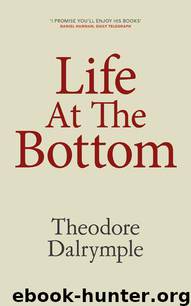Life at the Bottom: The Worldview That Makes the Underclass by Theodore Dalrymple

Author:Theodore Dalrymple [Dalrymple, Theodore]
Language: eng
Format: epub
Tags: Social Science, Poverty & Homelessness, History, Europe, General, World, Political Science, Political Economy, Public Policy, Social Policy
ISBN: 9781615780198
Google: GR5vAAAAQBAJ
Publisher: Ivan R. Dee
Published: 2003-03-07T23:00:00+00:00
1997
CHOOSING TO FAIL
THE CHILDREN OF IMMIGRANTS from the Indian subcontinent make up a quarter of all British medical students, twelve times their proportion in the general population. They are likewise overrepresented in the law, science, and economics faculties of our universities. Among the Indian immigrants who arrived in the country with next to nothing, moreover, there are now reportedly some thousands of millionaires.
Despite its reputation for being ossified and class-ridden, then, Britain is still a country in which social mobility is possible – provided, of course, that a belief that Britain is an ossified and class-ridden society doesn’t completely stifle personal effort. It is the mind, not society, that forges the manacles that keep people enchained to their misfortunes.
But where there can be upward social mobility, there can be mobility in the opposite direction. And the children of Indian immigrants are dividing into two groups: a segment that chooses the upward path, and a segment that chooses descent into the underclass.
Sometimes this division occurs within the very same family. For example, last week I met two prisoners of Indian origin, all of whose siblings had gone to college and become either professional or business people. Their brothers and sisters had chosen law, medicine, or commerce: they had chosen heroin, burglary, and the intimidation of witnesses. The financial status of their parents could not explain their choices: the father of one was a bus driver, the second a successful travel agent, and both fathers had been not only willing and able but longing to fund their higher education, had they wanted it.
I first noticed signs of a developing Indian underclass a few years ago in the prison in which I work, where there has been an inexorable rise in both the absolute and relative numbers of prisoners of Indian origin. In the last eight years the proportion of Indian prisoners has more than doubled, and if it continues to rise at the same rate for the next eight years, prisoners of Indian origin will have surpassed their proportion in the general population. As the proportion of Indians in the age group most likely to be imprisoned has not increased, demography doesn’t explain this shift.
Eight years ago, most of the Indian prisoners were guilty of white-collar crime, such as tax evasion: not the kind of thing to make you fear to walk the streets at night. All that has changed now. Burglary, street robbery, car theft, and drug-dealing, with their attendant violence, have become so commonplace among them that mention of their seriousness elicits only a bored shrug of incomprehension. Why make a fuss over anything so ordinary as a street robbery? Everyone does it.
Liberals to whom I have mentioned the phenomenon applaud it as representing the assimilation and acculturation of an ethnic minority into the wider society. They are right to view this development as a cultural phenomenon. There are many other outward signs of the acculturation of Indians into the lower depths. Although their complexions are by no means well adapted to it, tattooing is fast on the increase among them.
Download
This site does not store any files on its server. We only index and link to content provided by other sites. Please contact the content providers to delete copyright contents if any and email us, we'll remove relevant links or contents immediately.
The Secret History by Donna Tartt(16692)
The Social Justice Warrior Handbook by Lisa De Pasquale(11501)
Thirteen Reasons Why by Jay Asher(7815)
This Is How You Lose Her by Junot Diaz(5810)
Weapons of Math Destruction by Cathy O'Neil(5064)
Zero to One by Peter Thiel(4846)
The Myth of the Strong Leader by Archie Brown(4801)
Promise Me, Dad by Joe Biden(4463)
Beartown by Fredrik Backman(4453)
How Democracies Die by Steven Levitsky & Daniel Ziblatt(4436)
Stone's Rules by Roger Stone(4430)
The Fire Next Time by James Baldwin(4358)
100 Deadly Skills by Clint Emerson(4097)
A Higher Loyalty: Truth, Lies, and Leadership by James Comey(4047)
Rise and Kill First by Ronen Bergman(4031)
The David Icke Guide to the Global Conspiracy (and how to end it) by David Icke(3901)
The Farm by Tom Rob Smith(3886)
Secrecy World by Jake Bernstein(3795)
The Doomsday Machine by Daniel Ellsberg(3744)
